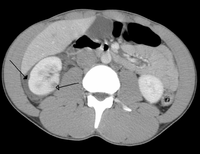
Photo from wikipedia
Abstract To evaluate the value of ultrasonography in the diagnosis of anterior cruciate ligament injury (ACL injury) by conducting a systematic review and meta-analysis. A literature search was carried out… Click to show full abstract
Abstract To evaluate the value of ultrasonography in the diagnosis of anterior cruciate ligament injury (ACL injury) by conducting a systematic review and meta-analysis. A literature search was carried out in the Cochrane Library, Embase, Pubmed databases and included studies prior to April 2017. Based on inclusion and exclusion criteria, studies evaluating ultrasound to diagnose ACL injury were selected. MRI, arthroscopy and clinical-follow were considered the reference standards. The diagnostic accuracy of ultrasound was assessed using a combination of sensitivity, specificity, likelihood ratio (LR), post-test probability, diagnostic odds ratio (DOR) and by summarizing the area under the receiver operating characteristic (SROC) curve. A total of 4 studies involving 246 patients were eventually included in the analysis. In these four studies, the combined sensitivity, specificity, positive likelihood ratio, negative likelihood ratio, post-test probability and DOR were 90.0% (95% CI: 77–96), 97% (95% CI: 90–99), 31.08 (95% CI: 8.75–110.41), 0.11 (95% CI: 0.05–0.24), 89% (3%) and 288.81 (95% CI: 78.51–1062.48), respectively. The area under the SROC curve was 0.98 (95% CI: 0.97–0.99). Our meta-analysis showed that ultrasound can play an important role in the diagnosis of ACL injury. Because of its high sensitivity, high specificity and high diagnostic ability, ultrasound should be a part of the standard diagnostic work-up of an ACL injury.
Journal Title: European Journal of Sport Science
Year Published: 2018
Link to full text (if available)
Share on Social Media: Sign Up to like & get
recommendations!